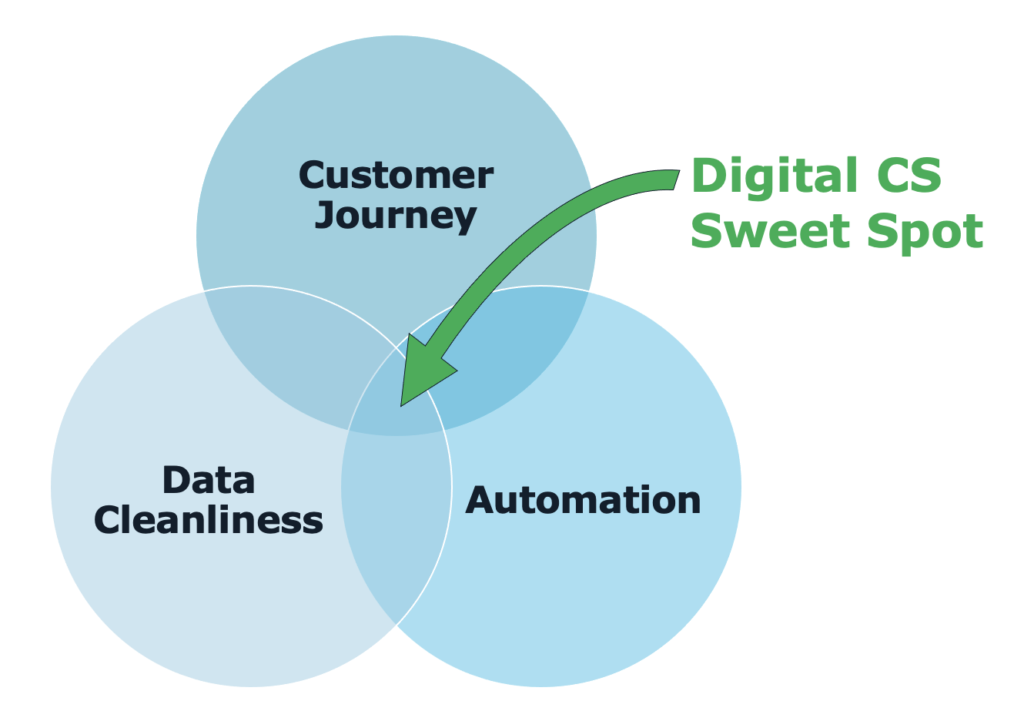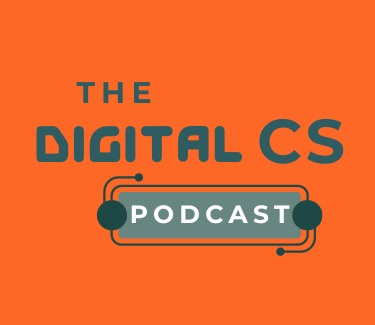If you’re getting into the world of Digital Customer Success (DCS), it can be hard to identify some of the building blocks for a successful program. Even veteran CS & Operations leaders sometimes struggle cultivating vibrant digital programs.
Why? It’s likely because they are missing one or more of the key foundational elements associated with what I like to call The Digital Customer Success Sweet Spot: That magical place that exists at the exact intersection of:
- Your well thought out Customer Journey
- A clean and “healthy-ish” Customer Data set
- Your ability to Automate within the confines of the systems & resources you have.
In this article, I’m going to lay out the three foundational pillars necessary to run a Digital Customer Success program that gets your content to the right person at the right time…every time.

But First…What is Digital Customer Success?
There are many definitions of Digital CS out there. For instance, a page on this website (The Digital Customer Success Definition Word Map), captures the many definitions provided by guests of the podcast who are by all accounts industry experts.
As you’ll see when you peruse the list of definitions, there is wide variety in how the industry defines DCS. This largely depends on the individual’s background, current role, operational experience and personal interest.
That said, there are certain commonalities that most of these definitions share.
For fun, I asked ChatGPT for help to provide us with a summary of all of the definitions I’ve collected. Here’s what it came up with:
“Digital Customer Success (DCS) is a strategic use of technology and automation to align organizational elements and enhance product adoption, efficiency, and personalized experiences for customers. It aims to make customer success more efficient, consistent, and accessible, combining digital tools with human touch points to drive value across the customer lifecycle.”
Not too bad if you ask me.
So, now that we’ve laid out the definition, let’s dive deeper into the three pillars of The Digital CS Sweet Spot.
Pillar 1: Customer Journey
In uttering perhaps one of the most over-used terms in customer success, I likely made your eyes roll just a little bit. This is understandable given how frequently the topic of the Customer Journey has been discussed and analyzed within the CS community.
The fact remains that it is a critical part of our work though. In fact, I think that it is perhaps one of the most important elements to digital CS in particular as the function essentially coordinates all of its activities (and those of other departments) around a clearly defined customer and user journey.
A customer journey can be laid out in any number of different ways. For our purposes however, what we are primarily interested in is to define the key touch points along the journey where digital and human intervention are key to driving customer outcomes.
In defining these touch points, there are basically three categories into which you might organize them:
- Your Own Company Calendar
Think user summits, office hours, ask-me-anything sessions, webinars, conferences, newsletter releases, etc. This category consists of any pre-scheduled event, not related to a customer’s specifc journey which you will want to promote to your customer contact list. Doing so proactively helps to drive attendance at these events and increases your customer’s knowledge and comfort in your products and services. - Customer Lifecycle Events
These touch points are defined by how far advanced in the journey your customer currently is and by how well (or poorly) they are doing within that journey. As such, I would classify this category into two sub-categories:- Time-Based Events: Examples could be onboarding flows, business reviews or pre-renewal activities.
- Triggered Events: These are engagements based on customer activities and triggers you establish. Examples would include engaging if logins drop-off or if you see a spike in support cases being entered. Additionally, these triggers should also include celebratory points where you callout customer contacts for completing tasks that lead to positive outcomes.
- User Specific Engagement
When new users sign on to the platform for the first time, there are motions you’ll want to implement to make sure those users are properly educated in the usage of the platform/tool. You’ll also want to engage the user at key moments based on their usage statistics and you’ll want to do so in a way that meets them where they are.
As you can see, defining the customer journey with digital motions in mind is a bit more involved than simply laying out a single stream of generalized activities for every customer. While some of the engagement points are time based and consistent across your customer base, others are activity based, unique to each customer or persona. As such, your typical timeline approach to customer journey will also need to accommodate for documenting those ‘just-in-time’ moments which occur on an ad-hoc basis.
Pillar 2: Data Cleanliness
In the first few paragraphs of this article I used the word ‘healthy-ish’ in referring to the need for clean data in digital CS. That is to say that completely clean data sets are not necessarily required to run digital programs. In fact, I would argue that completely clean data sets are unachievable, especially given the vast amount of influences to your data ecosystem.
That said, it is quite likely that as you embark upon your journey to digital maturity, you’ll want to run some data hygiene exercises focused on a few particular fields or portions of your data. This will come out of the prioritization work you do in establishing a program, combined with a gap analysis of what you’re missing to make it work.
Any way you slice it, if you’re implementing a digital program at some point you will find yourself digging through data exports and running validation exercises.
At the end of the day, the ultimate goal in this pillar is to get to a high degree of confidence in the quality and accuracy of your data around the specific motions and metrics you’re putting in place. The risk of not investing some time in the validation of your data is that you’ll end up implementing programs that cause erroneous triggers, questions from the team(s) and ultimately a lack of faith in the overall program or tech stack.
If you’ve analyzed your data and determined that some hygiene activities need to take place, the thought of cleaning the data yourself can become daunting, especially if you’re dealing with a lot of records and fields.
In some cases, it makes sense to spend the time to do the updates yourself. Having done this myself, I’m always surprised by something that I’ve learned about our data or customers in the process. I would advise you to use your tools wisely. For example, if a single field needs to be updated across multiple account records, it would likely be faster to handle that via file export/import rather than manually updating each record individually.
In the majority of cases, I would actually recommend a concerted, cross collaborative effort to update fields. This type of activity will require some coordination and possibly some incentives, but having multiple individuals involved could make quick work of a major effort. In fact, I might even recommend making a party out of it by inviting everyone involved into a few sessions, provide some beverages and music. It might as well be fun, eh? This activity is also well worth a few dollars spent in gift cards.
I’ve written more about data hygiene in other articles on this site if you’re interested.
Pillar 3: Automation
This section is listed last on purpose as the temptation is usually to jump into heavy automation first before getting a good footing on your current state situation. In reality, major automations shouldn’t be tackled until you’ve gotten a good handle of your overall journey and data quality. I say major because I’m also a big advocate for not delaying the start of digital implementations for the sake of perfection.
In other words – start where you can have immediate impact with the infrastructure and data that you have, while simultaneously preparing for more complexity down the road.
Onboarding emails are a great example of something where you generally know what needs to happen and you likely have a decent handle on who your audience is for that motion. I would not delay getting these kinds of programs stood up.
That said, there are complex automations which I would not recommend implementing prior to tackling pillars 1 & 2. A few examples of these would include:
- Telemetry/usage based triggers
- Pre-renewal flows
- Persona-specific engagements
- NPS or Survey Programs
Spending some upfront time honing in on a well defined customer journey and defining what data improvements need to be made will pay off massively down the road when it comes time to implement these complex programs.
You’ll notice that I haven’t spent any time talking here about specific tools, plugins, chrome extensions, etc. I don’t really plan to either. This is because there exists a vast sea of tools out there that solve for these kinds of business problems and part of the challenges if figuring out which tools are appropriate for all of the other variables which you face.
There are definitely some tools that come to mind when it comes to CS automations (any CSP, Zapier, Marketo, Hubspot…etc.). Part of the equation in implementing your automations is examining what tools you already have in place that can help get you to the finish line and then identifying the gaps that you need to solve for.
Putting It All Together
The variables involved in building a digital customer success program are vast. From tooling to data, customer personas to products supported, cross-functional alignment to CSM coverage – the combinations are endless. That is why it is literally impossible to create a single template/playbook for how to build a DCS program.
The Digital Success Sweet Spot is meant to offer a set of guardrails from which to design your program specific to the variables you face. Ensuring that each of the three pillars is accounted for in your planning will help ensure that you are building a high quality DCS program that is setup for success and future expansion.
NEWSLETTER SIGNUP
Want to see more content like this?
Sign up for my weekly newsletter for updates about the podcast, as well as digital CS best practices! No spam – I promise.

